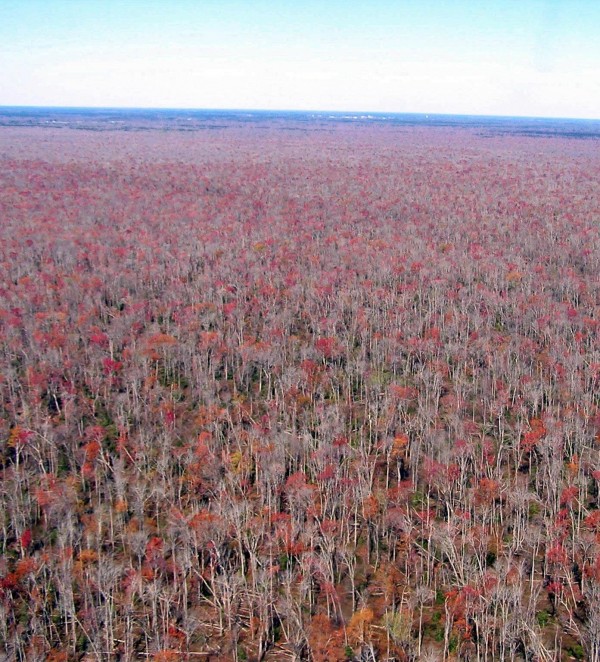In touch with Wayne's warbler
Azalea returns to Little Wicomico River
September 13, 2009Azalea remains in Northumberland County
September 14, 2009
Written by Bryan Watts
September 13, 2009
The Wayne’s warbler (Dendroica virens waynei) is a unique, disjunct subspecies of the black-throated green warbler. The nominate race (D. v. virens) breeds in coniferous forests across the northern latitudes of North America and through the higher elevations of the Appalachians. The Wayne’s form is smaller than the nominate race and has a distinctly smaller bill. Wayne’s has a much smaller breeding range and is restricted to the South Atlantic Coastal Plain from southeastern Virginia to South Carolina. Along much of this range, the population is confined to a fairly narrow band within the outer coastal plain. This population is 500 km east of the Appalachian population and 1,200 meters lower in elevation.

Aerial view of the Great Dismal Swamp in May, showing a sea of red maples in bloom. Due to extensive logging and changes in hydrology, hardwoods, like the red maple, have replaced white cedar here. Photo by Bryan Watts.

Stacks of cedar shingles ready to be shipped to New England for use in house construction. Logs for these shingles were harvested from areas around the Great Dismal Swamp during the early 1900s. Photo by American Lumberman.
The factors that lead to the isolation of the Wayne’s form from the nominate race of black-throated green warbler are not known. However, isolated forms of other warblers such as the worm-eating warbler, prairie warbler, and black-and-white warbler also occur within this area. Wayne’s appears to have been associated with the extensive stands of Atlantic white cedar that were once an important component of the regions plant community and whos distribution matches that of the warbler. These stands were similar in form to the coniferous forests where D. v. virens currently breeds. Wayne’s warbler appears to reach its highest density from southeastern Virginia through northeastern North Carolina. This was the former location of the most extensive tracts of white cedar. White cedar was the most valuable tree throughout the Southeast and more than 100,000 acres of this habitat were harvested in the area in the late 1800’s and early 1900’s for the shingle industry. This event virtually eliminated this unique plant community from the region. The vegetation that has reclaimed many of the historic sites after harvest is dominated by hardwoods rather than white cedar.
The Center for Conservation Biology established a network of 265 survey plots within Virginia and North Carolina that spanned the gradient of forest types within the region to examine breeding density, habitat use and distribution. Birds were detected on 13% of 1,862 surveys conducted. The Dare Bombing Range and Alligator National Wildlife Refuge appear to be among the remaining strongholds for the Wayne’s form. Plots containing Atlantic white cedar, bald cypress, and/or loblolly pines were more likely to support birds than sites dominated by hardwoods.
By most accounts throughout the breeding range, the Wayne’s warbler has been declining for many years. However, very little is currently known about the ecology and requirements of this unique form of black-throated green warbler.
Project sponsored by The Center for Conservation Biology (CCB) and the U.S. Fish & Wildlife Service (USFWS).




